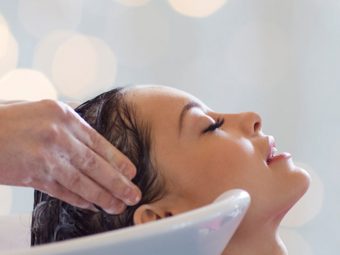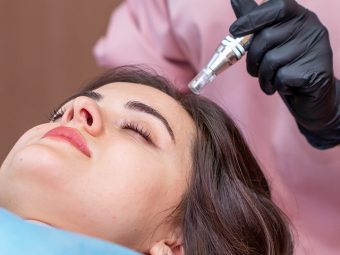High-Frequency Hair Treatment: Benefits And How It Works
Understand the nuances of this effective hair regrowth technique before you opt for it.

Image: Shutterstock
The high-frequency hair treatment has frequently been mentioned in most beauty blogs in recent times. The therapy promises to tackle hair loss and dandruff and works by stimulating hair follicles with the help of UV and high-frequency rays.
But is this scalp treatment effective and safe? This article will dig deeper into the procedure and potential benefits and side effects of this scalp treatment. Read on!
In This Article
What Is High-Frequency Treatment For Hair?
The high-frequency treatment is an intensive hair therapy used to treat hair loss, hair thinning, dandruff, and alopecia. It uses ultra-violet and high-frequency rays to stimulate the hair follicles. The treatment boosts blood supply to the hair follicles, drawing nutrients to the roots, encouraging hair growth.
The high-frequency hair treatment machine is a transparent rod-like tool with two different removable knobs or combs that generate electrical stimulation at a frequency of 250,000 Hz when it touches the scalp.
A glass bulb is fixed to the high-frequency rod during treatment to expose the scalp to high-frequency rays. This treatment can also be used on the face and body to treat pimples and acne scarring.
The high-frequency treatment is relatively new and lacks scientific backing regarding its benefits. All claims of the machine improving hair growth are purely anecdotal.
In the next sections, let’s understand how this treatment works.
How Does The High-Frequency Treatment Promote Hair Growth?
The treatment uses electricity to boost hair growth. Animal studies suggest that electrical stimulation can trigger hair growth (1). However, more research and human trials are required to understand the effectiveness of high-frequency scalp treatments.
The high-frequency treatment promotes hair growth in three different ways:
- It stimulates the hair follicles, promoting faster hair growth.
- It improves blood circulation to the scalp, allowing nutrient delivery. This nourishes the scalp and promotes hair growth.
- It improves cell turnover rate, minimizes dandruff, keeps the scalp healthy, and maintains overall hair health.
The high-frequency hair treatment is done under the guidance of a professional trichologisti XA professional that studies and specializes in conditions and treatments related to the hair and scalp. . Here is what you can expect during the treatment.
High-Frequency Hair Treatment Procedure And Duration
- The hair is divided into 5-6 sections.
- The comb is used on the affected area for 2-3 minutes.
- This is followed by a hair massage for 20-25 mins.
- A conditioning mask is applied from the roots to the tips.
- The professional then steam the hair for 10 minutes and exposes it to UV bulb rays for another 7-8 minutes.
- You need to wash your hair the next day of the treatment.
This high-frequency hair treatment takes about 50 minutes. You may need multiple sessions for the best results.
 Quick Tip
Quick TipHow Often Should You Carry Out This Treatment?
Usually, the doctor suggests at least 10-12 continuous sessions, twice or thrice a week. Depending on the result, the treatment frequency may reduce from once or twice a week to once every fortnight. You may need to continue the treatment to promote hair nourishment and hair restoration to maintain your hair health.
Besides hair growth, this microcurrent treatmenti XA non-invasive process that involves the use of low level electric current that is similar to the body’s natural current flow. can offer a slew of hair benefits.
What Are The Benefits Of High-Frequency Hair Treatment?
As per anecdotal evidence, high-frequency hair treatments can improve scalp and hair health in the following ways:
1. Protects The Hair From Dandruff And Itchy Scalp
The high-frequency microcurrents produced by the machine stimulate the scalp and activate the sebaceous glands. These glands produce sebum, a natural substance that moisturizes the scalp and kills bacteria (2). Both actions can eliminate dandruff and scalp itchiness that leads to hair loss.
Anecdotal evidence suggests that the heat generated by the device eliminates bacteria and other pathogens from the scalp.
2. Slows Down Hair Thinning
The high-frequency scalp treatment prevents dead skin cell accumulation and circulates oil throughout the scalp. This rejuvenates the hair follicles, making them stronger and more resilient to hair fall and thinning.
During the treatment, the scalp massages improve blood flow to the scalp and increase hair thickness, hence it is an effective hair loss prevention therapy(3).
3. May Help With Stress Reduction
High-frequency hair treatments may help reduce stress by offering a relaxing and soothing experience. Their gentle massaging effect can help alleviate tension and promote a sense of well-being. Additionally, the improved blood circulation stimulated by the high-frequency current can help reduce muscle tension. The release of endorphins during the treatment can also promote a feeling of calmness.
4. Promotes Relaxation
The treatment process requires frequent head massages and hair steams, which soothe the scalp and promote relaxation.
The high-frequency hair treatment is relatively safe; however, it may cause a few side effects. Read on to know more.
Nora, a YouTuber, shared her experience of using a portable high-frequency device for hair growth. She explains, “I feel like it works…Does it burn the scalp? No! But, it’s like little shocks going into your scalp. It actually feels kind of good. So, it’s just like a little micro-shocks going into your scalp. So, what I read was: it helps stimulate oxygen for hair growth. It helps bring more blood and allow blood to flow (i).”
High-Frequency Hair Treatment Side Effects
- The hair can feel drier after the treatment.
- The sebaceous glands may get overstimulated, causing excess sebum production and greasy scalp.
- The heat from the machine may leave dark marks or scars on the treated area.
- May cause swelling, especially if one has sensitive skin or develops an allergic response to the treatment itself.
 Quick Tip
Quick TipConsult a doctor before opting for high-frequency hair treatment. Not everyone is eligible to undergo this treatment.
Who Should Avoid The High-Frequency Hair Treatment?
Avoid high-frequency treatment if you:
- Have any autoimmune disordersi XA group of conditions resulting from a faulty immune system that attacks perfectly healthy cells in the body. like rheumatoid arthritisi XAn autoimmune ailment that mainly impacts the joints of the human body, including those in the hands and feet.
- Have pacemakersi XA medical device implanted in the chest to control the heartbeat by generating electrical impulses to the heart chambers. or any large metallic implants in your body
- Are pregnant
Note: If you experience excessive hair fall suddenly, consult your dermatologist to determine the cause and then start the treatment.
Infographic: A Complete Guide To High-Frequency Hair Treatment
The high-frequency hair treatment is an excellent therapy for treating alopeciai XA skin condition characterized by either partial or complete loss of hair from parts of the human body, especially the scalp. , dandruff, and hair loss. If you want to know more about this procedure, you have come to the right place. We have created a comprehensive guide on the procedure and benefits of high-frequency hair treatment for you to look at. Check out the infographic below to know more! Illustration: StyleCraze Design Team
Save the high-quality PDF version on your device now.
Download Infographic
High-frequency hair treatment is a medical procedure that uses high-frequency and ultra-violet rays to boost blood circulation to the hair follicles to increase hair growth. Anecdotal evidence suggests that this treatment also reduces hair fall and protects the hair from dandruff and itchy scalp. While the treatment is safe, you may experience dry hair and a greasy scalp after the procedure. People with autoimmune conditions or pregnant women should avoid high-frequency hair treatment. Please consult your doctor to understand the benefits and risks of the treatment before you go for it.
Frequently Asked Questions
Can I use high-frequency every day?
No, it is not safe to use high-frequency therapy every day. However, it can be used twice or thrice a week as an effective hair care and hair repair technique.
What cream do you use with a high frequency?
Professional oxygenatingi XOxygenating is the process of impregnating, combining, supplying, or treating something with oxygen. creams are generally used with a high frequency.
Does high-frequency help blackheads?
Yes, high frequency can significantly reduce blackheads. It increases oxygen supply and minimizes acne breakouts and blackheads.
Is high-frequency good for slowing down aging?
Yes, high frequency is good for slowing down aging. It improves blood circulation and triggers subtle tissue warming that exhibits anti-aging action.
Does high-frequency help with scars?
Yes, high-frequency effectively reduces scars.
Can you use high-frequency on folliculitis?
Yes, high-frequency can be used if you have folliculitis. It helps remove the ingrown hair and also helps in the management of the infection.
Can you use high-frequency on eczemai XEczema is the inflammation of the outer layer of the skin, i.e., the epidermis. It is a type of dermatitis. ?
Yes, high-frequency can be used to manage eczema. It also speeds up the healing process.
Do high-frequency wands hurt?
No, high-frequency wands don’t hurt. They trigger a mild tingling sensation.
Can I use high-frequency after Botox?
No, high-frequency cannot be done immediately after Botox. It is advisable to maintain a gap of at least 1 week.
Is high-frequency good for cellulite?
Yes, high-frequency is good for managing and reducing cellulite in combination with a good cellulite product.
Key Takeaways
- High-frequency hair treatment promotes hair growth and helps treat dandruff, hair thinning, and alopecia.
- The treatment takes around an hour, and you may need to attend multiple sessions.
- Though it is safe, it may cause a few side effects like dry hair and greasy scalp.
Watch this video to learn more about the amazing benefits of high-frequency hair treatments. Know how this revolutionary technique can help you achieve thicker, longer, and healthier hair.
Personal Experience: Source
i. Portable High Frequency Device – Hair Growth, Scam or Legitimate?
https://www.youtube.com/watch?v=k9Im6S8tiPM
Sources
- Self-Activated Electrical Stimulation for Effective Hair Regeneration via a Wearable Omnidirectional Pulse Generator
https://www.ncbi.nlm.nih.gov/pmc/articles/PMC6881522/ - Sebaceous-immunobiology is orchestrated by sebum lipids
https://www.ncbi.nlm.nih.gov/pmc/articles/PMC5821166/ - Standardized Scalp Massage Results in Increased Hair Thickness by Inducing Stretching Forces to Dermal Papilla Cells in the Subcutaneous Tissue
https://www.ncbi.nlm.nih.gov/pmc/articles/PMC4740347/





























